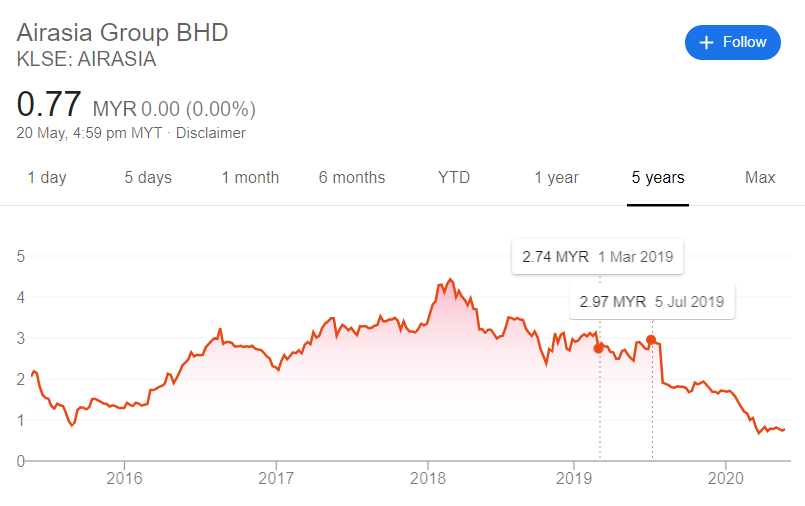I started my investing journey without any clues of what is risk tolerance, for at least one year period. Heck, does it matter anyway? As long as I know how to identify stocks that give me a better return, then I can grow my capital at high speed, right?

In March 2019, I bought Airasia as my first stock at an average price of RM2.60 (Enter at RM2.74 and RM2.50). When it declared a 90 cents special dividend, I sold off all my Airasia stocks at RM3.02 with a profit of RM1,600 (16% return) in just 4 months. This sweet victory gave me a boost in confidence, proving that I might be a great investor in the future.
Overconfidence is Risky

Fast forward to the year 2020 when Covid-19 invaded our world, I was holding a lot of high volatility stocks such as FOUNDPAC, MI, and MASTER. They were my precious stocks back then because of their fast growth.
Afterward, the unexpected quarterly result of MASTER and the 2020 Stock Market Crash came and hit me on the face, making me panic sell almost all my stocks.
Indeed, I should have known that the way I invest exposes myself nude on the volatility of the stock market. Hence I did some research to find the root causes of my panic sell. This is when I learn about risk tolerance.
You can’t stand volatility and had a heart attack in March?
— TheDividendGuy (@TheDividendGuy) May 18, 2020
Now is the time to rethink your portfolio. Market is uuuup!
You should have assessed your risk tolerance correctly years ago.
If it’s the case, now is the time to do nothing.
Risk Tolerance is The Speed Limit

Let’s imagine that each of us is a vehicle, and risk tolerance is our max speed limit. We can have a similar destination, but we may have different speed limits.
If you are just a small Perodua Axia with a top speed of 155km/h, you don’t want to drive the same speed with the Mercedes Benz with a top speed of 300km/h. You will see yourself shaking vigorously and drifting when you are over your limit.
When you know your max speed limit, you won’t risk yourself by driving over the limit. You might see yourself slower than others, but at least you feel comfortable and secured while driving on the road of investing.
Wait, is this mean I am going to be the turtle car for the rest of my life?
Of course not. When you upgrade your income, knowledge, and skills in investing, you will transform into a more powerful vehicle. Your speed limit (risk tolerance) may change when you upgrade yourself.
Knowing Your Limit

While we talk about stock investing, risk tolerance means the ability one can endure the potential of losing money in an investment.
In general, risk tolerance can be categorized into 3 common types:
- Conservative: People who are conservative in preserving their capital. They only can accept investing in assets that almost guaranteed capital return and easy to withdraw money from it.
Suitable Assets: Fixed Deposit, Money Market, Bonds - Moderate: People with moderate risk tolerance usually aim to achieve well-balanced investments that mixed with instruments that are stable and lower volatility. Most of them love the dividend return from stocks.
Suitable Assets: ETF, Dividend Stocks, REIT - Aggressive: People who are aggressive usually have decent knowledge in the market and love highly volatile instruments. They maximize their returns by investing all kinds of instruments including options and warrants.
Suitable Assets: Growth Stocks, Warrants, Options
Here are some of the questionnaires that I found to be very useful in identifying our risk tolerance.
- CalcXML – Risk Tolerance
- Stock vs Bond Allocation (Vanguard)
- Charles Schwab – Investor Profile Questionnaire

When you know your risk tolerance, you may follow the investing strategy provided by Charles Schwab as shown in the image above.
After that quiz, I found that my risk tolerance is only around moderate. As expected, I shouldn’t have populated my portfolio with so many growth stocks. So I adjusted my strategy to buy only 1 to 3 growth stocks, and the rest will be stable or growing dividend stocks.
Risk-Reward Tradeoff
I bet you hear this words often in investing. “High Risk, High Reward”.

The above chart shows 3 types of hypothetical investments with different volatility. When you want to invest for the maximum return, you should also make sure you can accept the maximum loss possible as well.
In reality, every investor will experience losing money. The key to a successful investment is you should have more gains than losses. Once you have acknowledged your risk tolerance, it will help to get your emotion in control in the long run.
Choose Your Weapon

If your ideal asset portfolio has been set, then you will have the upper hand in choosing the best investing approach that suits you.
When I started investing, I have no idea which investing approach I should choose. Dividend investing, value investing, or growth investing? (Not going into details on investing approach here. Maybe in another article)
But when I know my risk tolerance, I wouldn’t go all-in with growth investing. Now I focus more on building a portfolio that gives me solid dividends rather than high capital gains.
The Change Factors
Having said that, your risk tolerance in investing might change due to several factors:
- Age – If you are still 20-ish, your risk tolerance could be geared toward aggressive as you still have an abundance of time ahead of you. While those who are near to retirement age definitely wouldn’t go aggressive.
- Income – With low income, you wouldn’t have much savings to invest. That’s actually a good opportunity to take the risk for a higher return. But again, it also depends on your own risk appetite and age.
- Knowledge – When you invest in the market for some time and gain some experience, you may have the confidence to try riskier investments.
- Marriage Status – Your risk tolerance will change when you have an additional commitment to your partner or family.
- Life Events – This can be applied to many things such as preparing for a wedding, welcoming a new baby, buying a new house, or renovating your home.
Conclusion

To summarize above article, I would say the benefits of knowing your own risk tolerance are:
- Better emotion control in your investing journey.
- Find the suitable Asset Allocation for your portfolio.
- Able to choose and stick to your investing approach.
Investing is personal and different for everyone. Even when all your friends around you like to invest in high-risk investments, it doesn’t mean you have to follow.
Know your risk tolerance, and invest in assets that you are comfortable with.
What is your risk tolerance and what investments you have invested recently?
Blog Update & Social Media
If you like this article, then you may like my other articles as well. If that so, feel free to subscribe to my newsletter so you can get the latest update from me when I posted a new article. 🙂
[mc4wp_form id=”236″]
Also, you can also get my new blog post updates by following my social media below. Don’t be shy and feel free to interact with me as well. See you there!
